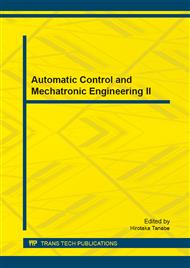p.101
p.109
p.113
p.117
p.122
p.126
p.132
p.139
p.143
Characteristics of the Linear Piezoelectric Motor with Semi-Elliptical Stator
Abstract:
A novel design of the semi-elliptical motor based on a double-mode type ultrasonic motor is proposed and analyzed in this paper. Due to the simplification, the semi-elliptical piezoelectric motor can be considered as an improvement of the elliptical piezoelectric motor which we have proposed in the past. The composite structure of the stator in the motor is formed by two multilayer piezoelectric actuators clamped in a semi-elliptical elastic body. In the simulation, finite element modeling of the motor is performed. The geometry of the stator has been computed with the help of the finite element analysis. Then, the dimensions of the stator's structure were determined by making the two resonance frequencies close to each other. In the experiments, the impedance and the displacement response are measured and discussed for understanding the characteristics of the linear piezoelectric motor with a semi-elliptical stator. The motor achieved maximum moving speed of 96 mm/s and the maximum output force of 0.64 N when applying a sine wave of 14Vr driving voltage at 21.2 kHz, while the maximum moving speed of 132 mm/s and the maximum output force of 0.88 N can be achieved if applying two signal driving method of the same voltage.
Info:
Periodical:
Pages:
122-125
Citation:
Online since:
September 2013
Authors:
Price:
Сopyright:
© 2013 Trans Tech Publications Ltd. All Rights Reserved
Share:
Citation:


